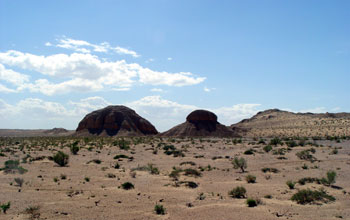Multimedia Gallery
The Qaidam Basin
The Qaidam Basin, the largest terrestrial basin on the Tibetan Plateau, where a team of researchers funded by grants from the National Science Foundation (INT 02-04923 and EAR 04-44073) studied fossils, sediments and paleoenvironments. [One of seven related images. See Next Image.] [Date of Image: July 2005]
More about this Image
The purpose of the study, which was led by Yang Wang, a professor of geochemistry at Florida State University, and professor Deng Tao of the Institute of Vertebrate Paleontology and Paleoanthropology, CAS, China, was to survey Cenozoic fossils in the northern Tibetan Plateau. Due to difficulties of access and extreme environments, the vast plateau is little explored and remains the last frontier for paleontological explorations.
Preliminary surveys in the Qaidam basin, the largest terrestrial basin in the Tibetan Plateau, yielded a number of richly fossil-bearing localities ranging from early Miocene (about 24 to 16 million years ago) to Pliocene (about 5 to 2 million years ago).
A team of paleontologists, structural and sedimentary geologists, isotope geochemists and paleomagnetists are systematically collecting fossilized mammals, fish and plants in the Qaidam basin and studying their paleoenvironments. Combined with paleomagnetic studies, the fossils help to establish the age of the rocks in which they were preserved.
Sedimentologic studies on the river, lake and over-bank deposits also provide further evidence about the source of the sediments from the surrounding mountains; the nature of the paleodrainages; and the evolution of the basin history. Analyses of carbon and oxygen isotopes preserved in fossil mammalian teeth provide valuable information about the animal's diet (Was it a leaf browser or grass grazer?), environment (Did it live in the forest, on grassland or in wooded grassland?) and regional climate.
Scientists hope to better understand the link between the uplift of the Tibetan Plateau and the late Cenozoic environmental and biotic changes by integrating the paleontologic, magnetic, sedimentary and geochemical data. Comparing fauna from the southern slope of Tibet in India and Pakistan with the Qaidam fauna to the north will offer clues of mammalian migrations and geographic barriers as the high Tibet continued to rise. The new data are particularly relevant in the current debate over the impact of the rising Tibetan Plateau on climate, vegetation and mammalian evolution in the Cenozoic of Eurasia.
Credit: Photo by Dr. Yang Wang, professor of geochemistry, Florida State University
Images and other media in the National Science Foundation Multimedia Gallery are available for use in print and electronic material by NSF employees, members of the media, university staff, teachers and the general public. All media in the gallery are intended for personal, educational and nonprofit/non-commercial use only.
Images credited to the National Science Foundation, a federal agency, are in the public domain. The images were created by employees of the United States Government as part of their official duties or prepared by contractors as "works for hire" for NSF. You may freely use NSF-credited images and, at your discretion, credit NSF with a "Courtesy: National Science Foundation" notation.
Additional information about general usage can be found in Conditions.
Also Available:
Download the high-resolution JPG version of the image. (3.4 MB)
Use your mouse to right-click (Mac users may need to Ctrl-click) the link above and choose the option that will save the file or target to your computer.



